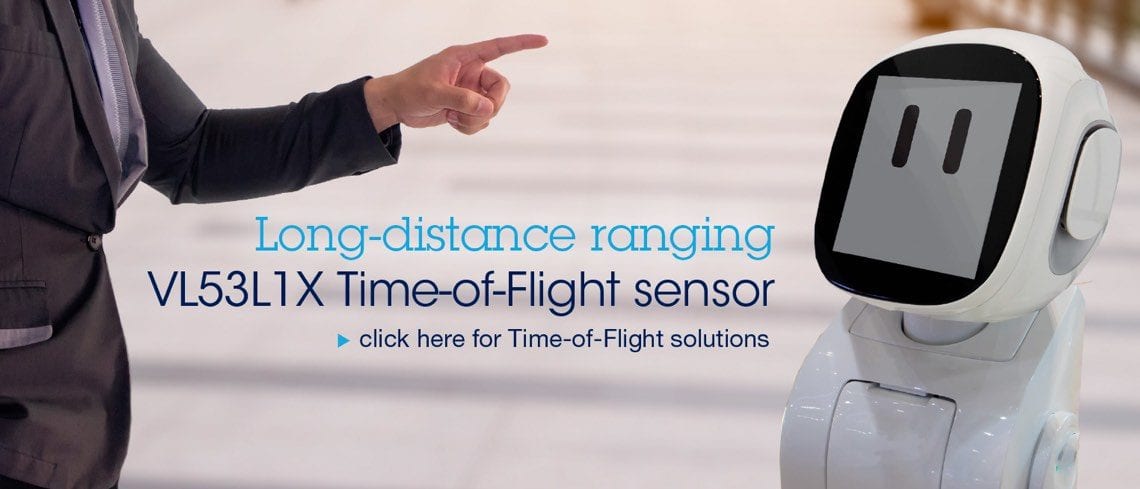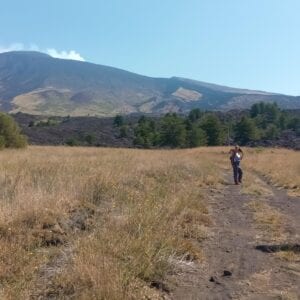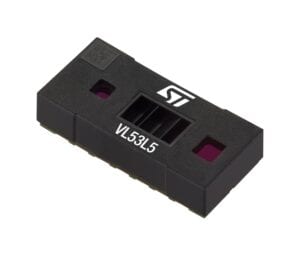
Update October 27, 2020
ST just announced the VL53L5, the first-time-of-flight sensor capable of monitoring 64 different zones. It is similar to the VL53L1X since they both share the same range and a 940 nm VCSEL. However, the new device is slightly bigger at 6.4 mm x 3 mm x 1.5 mm. The diagonal field of view is also much larger at 61º (43º horizontal and vertical), instead of 27º on the previous generation.
- Check out the VL53L5
Original Text, July 17, 2018
The VL53L1X is our longest ranging Time of Flight (ToF) sensor with a reach of up to four meters (about 13 feet). Despite doubling the range of the VL53L0X, the newer part is still a tiny module. Indeed, the VL53L1X has a 4.9 mm x 2.5 mm x 1.56 mm package, whereas the VL53L0X measures 4.4 mm x 2.4 mm x 1.0 mm, making it the smallest four-meter ToF sensor on the market. We decided to keep both devices to help designers choose the most appropriate component for their product. Those that don’t need the extra distance can profit from a smaller and more affordable solution while the engineers that do require more performance still have the assurance that the VL53L1X builds on everything we learned with the VL53L0X.
Webinar: Explore the New VL53L1X long-distance ranging Time-of-Flight sensor
Since its launch in 2016, the VL53L0X has remained the world’s smallest time-of-flight sensor thanks to leading-edge in-house packaging technology that enables the integration of a custom VCSEL (Vertical-Cavity Surface-Emitting Laser) and its driver, a SPAD (Single-Photon Avalanche Diode) receiver, and all the required circuitry in an all-in-one module. It was even one of the highlights of our 2017 Developers’ Conference, while the VL53L1X received the Gold Level Innovation Award a few weeks ago at the Sensors Expo and Conference. Indeed, the new part is quite popular because it retains so many of the original features of the previous component and builds on them to significantly increase performance. Hence, with so many third-party companies selling breakout boards integrating our latest model, and third-party products relying on our technology, we thought it was important to dive into three of the major features that explain the success of the VL53L1X.
Success Story #1: The Lens of the VL53L1X
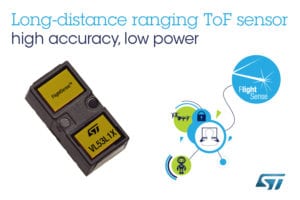
ToF sensors work by emitting photons from a VCSEL, then waiting for the light to bounce off an object and come back. The distance between the sensor and the object is then determined from the time the photons took to make a round trip. One of the primary reasons behind the massive increase in range is the integration of a lens in front of the receiving end of the sensor. The lens helps collimate the light coming back to the sensor, which means that the receptor can detect photons emitted by the laser and returning from a greater distance, thus increasing the device’s range. It also signifies that the VL53L1X is less affected by bright ambient light since the lens can better filter out ambient parasitic rays to better detect the photons making their way back.
Aside from increasing the sensor’s robustness against environmental interferences, the lens also allows for a programmable region of interest (ROI). Traditionally, an application will compute the distance of one or more objects by reading the information captured by the entire surface of the receiver, thus processing the whole field of view available – 27º in the VL53L1X. However, some applications don’t need the sensor’s entire field of view and trying to capture it in its totality is just a waste of resources, power, and computational throughput. Hence, we now offer the ability to limit the regions of the receiver that will transmit the information they capture, thus restricting the field of view to a specific region of interest.
Success Story #2: The Powerful API of the VL53L1X
Offering a hardware feature, such as a programmable region of interest, is remarkable, but we can already hear software engineers wonder how they will deal with all the registers and instructions to effectively take advantage of this technology. This is why we developed the STSW-IMG007, a set of C functions that serve as an API (Application Programming Interface) for the VL53L1X, which will facilitate the work of developers trying to take advantage of the sensor’s features. In the case of the sensor’s ROI, we offer dedicated commands to program the size and position of the field of view.
This API is truly powerful because it also gives developers the ability to create multiple regions of interest. For instance, designers can program the sensor to focus on the left side of the field of view, and then on the right side, thus scanning multiple zones. By doing this, the system can detect the presence of a hand moving from one side to the other, thus turning the VL53L1X ToF sensor into a swipe detector, which isn’t possible without multiple programmable ROIs. This is particularly interesting because it allows engineers to go beyond the traditional use cases of a time-of-flight sensor to offer new features and improve the user’s experience.
Success Story #3: New Low-Power Autonomous Mode
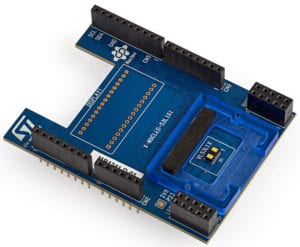
The API is also very helpful when taking advantage of the new low-power autonomous mode of the VL53L1X because developers only need to call the VL53L1_SetInterMeasurementPeriodMilliSeconds() function to take advantage of it. The new ToF sensor can be fully autonomous, meaning that it’s possible to put the rest of the system to sleep and benefit from massive power savings. Programmers simply call the function and define how often the sensor will check for activity (e.g., every second). The VL53L1X will then wake itself up automatically, according to the specified interval, and if it detects activity, such as someone arriving or leaving, it will generate an interrupt to wake the host microcontroller. Hence, the low-power autonomous mode can be particularly useful for PCs or smartphones that turn on their display when the user comes close to the machine, for instance.
The easiest way to start experimenting with the VL53L1X is to use our expansion board X-NUCLEO–53L1A1. It can sit on top of a Nucleo board, such as the NUCLEO-F401RE or the NUCLEO-L476RG, to quickly start prototyping. Developers only need to download the X-CUBE–53L1A1 software pack, which includes the VL53L1X API, drivers, Hardware Abstraction Layers, and even pre-compiled applications for both of the Nucleo board above, which means that engineers just have to drag and drop a binary to start using the sensor. The X-NUCLEO–53L1A1 also comes with two cover glasses that use different spacers to help designers test the ToF sensors under different air gaps, which will help simulate various environments. For those who don’t already own a Nucleo board, the P-NUCLEO–53L1A1 includes the X-NUCLEO–53L1A1 expansion and the NUCLEO-F401RE baseboard in one bundle.


